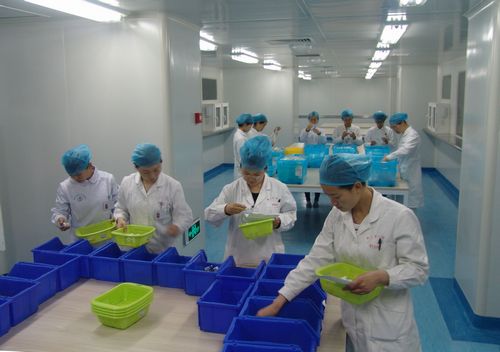I. Brief description of the development of intravenous drug dispensing centers Pharmacy intravenous admixture service (PIVAS). It refers to the operating environment designed by medical institutions based on the characteristics of drugs, in accordance with the requirements of intravenous drug dispensing, under the unified management of the pharmacy department, by trained professional and technical personnel, strictly in accordance with the requirements of aseptic operation, including parenteral nutritional solution, cytotoxic drugs and antibiotics, and other intravenous drug dispensing, to provide high-quality clinical infusion and pharmacy services of the functional departments.
Since the establishment of the world's first intravenous drug dispensing center in 1969, it has been widely carried out in developed countries. China's first intravenous drug dispensing center was established in 1999 in Shanghai Jing'an District Central Hospital, and since then, intravenous drug dispensing centers have been established in major provinces and cities one after another, and so far there are more than 300 of them in China.
II. Introduction to our hospital's intravenous drug dispensing center Our hospital's intravenous medication dispensing center is the first one in Liaocheng City, with a building area of 1,200 square meters built in March 2012, and formally operated on April 26, with an existing staff of 45, including 27 pharmacy staff, 11 nursing staff, 6 drug delivery workers, and 1 sanitary worker; among them, there is 1 deputy chief pharmacist, 3 pharmacists in charge, and 1 nurse in charge, etc. Since its establishment, it has been awarded the Quality Management Award and Advanced Department for two consecutive years. Since its establishment, it has been awarded the Quality Management Award and Advanced Department by the hospital for two consecutive years.
It is now configured with 35 sections, mainly configuring long-term medical prescriptions and temporary medical prescriptions for antitumor drugs and parenteral nutrition drugs, and dispensing an average of 4,500 bags of liquids per day; two dispensing rooms are set up in total, including antibiotics and cytotoxic drugs dispensing room, general and parenteral nutrition drugs dispensing room, and auxiliary zones are prescription reviewing area, drug discharge preparation area, finished product checking area, and secondary storage. The antibiotic and cytotoxic drug configuration room is equipped with 8 sets of BSC-Ⅱ-A2 type biological safety cabinets, which are used for the configuration of antibiotics, cytotoxic drugs and antitumor drugs; the general and parenteral nutrition drug configuration room is equipped with 9 sets of specially designed horizontal laminar flow tables, which are used for the configuration of electrolytes, total nutrient solution and other drugs, and the configuration area can accommodate 34 professional and technical personnel in 10,000 class cleanliness at the same time. The configuration area can simultaneously accommodate 34 professional technicians to carry out sterile configuration of intravenous drugs in a 10,000-level clean environment with local 100-level purification workstations. It provides high quality, safe and effective intravenous infusion and perfect pharmacy service for the clinic.
III. Significance of building intravenous drug dispensing centers 1. Ensure the quality of drug configuration and the safety of intravenous drug use. We ensure the stability of the finished product from the perspective of pharmacy specialty and eliminate the occurrence of contraindications in compounding. We transfer and mix in a strictly controlled environment with specialized training and in strict accordance with operating procedures, thus greatly reducing the probability of microbial, pyrogenic and particulate contamination avoiding the occurrence of infusion reactions and guaranteeing the safety of medication for patients.
2、Strengthen the monitoring of rational drug administration and improve the level of medical safety. Clinical prescriptions are transmitted to the intravenous drug dispensing center and reviewed by pharmacists to avoid medication errors. It improves the rational use of medicine and reduces the hospitalization cost of patients.
3、Reduce the waste of drugs and medical cost. Intravenous drug dispensing center realizes the relative concentration of medical resources and human resources and significantly reduces medical costs. Through centralized and standardized intravenous infusion mixing drug program, the IV drug dispensing center realizes centralized storage and management of drugs to prevent drug loss, deterioration and expiration, thus reducing waste.
4. Enhance occupational protection. In the traditional mixing environment, the staff is easy to be harmed by hazardous drugs, and the environment of the whole ward is also polluted, which is also a kind of harm to the patients in the ward. The IV drug mixing center mixes hazardous drugs in a closed environment, which reduces environmental pollution and strengthens the protection of occupational personnel.
5, improve the quality of care. Clinical nursing staff from the configuration of infusion of tedious work, saving more than 70% of the time, so that nurses have more time for patient treatment services, improve the quality of care, with obvious social and economic benefits.
The establishment of intravenous drug dispensing center in our hospital has changed the traditional workflow, established a new model of pharmacy service, developed clinical pharmacy, and served patients together with doctors and nurses. Ensure the safety of patients' medication, so that the IV medication dispensing center really becomes a platform for patients' safe, effective and economic IV medication, and really carries out patient-centered pharmacy service work to ensure the safety of patients' medication.
|




 鲁ICP备11009722号-4
鲁ICP备11009722号-4 